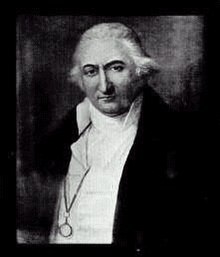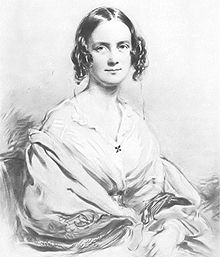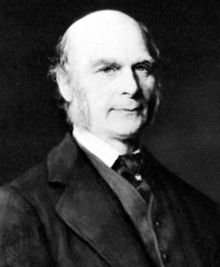Darwin–Wedgwood family
The Darwin — Wedgwood family was a prominent English family, descended from Erasmus Darwin and Josiah Wedgwood, the most notable member of which was Charles Darwin. The family contained at least ten Fellows of the Royal Society and several artists and poets. Presented below are brief biographical sketches and genealogical information with links to articles on the members. The individuals are listed by year of birth and grouped into generations. The relationship to Francis Galton and his immediate ancestors is also given. Note the tree below does not include all descendants (otherwise there would be many hundreds on it).

The first generation
Josiah Wedgwood

Josiah Wedgwood (1730-1795) was a noted potter and a friend of Erasmus Darwin; in 1780 on the death of Josiah Wedgwood's long-time business partner Thomas Bentley, Wedgwood turned to his friend Erasmus Darwin for help in running the business. As a result of the close association that grew up between the Wedgwood and Darwin families, one of Josiah's daughters later married Erasmus' son Robert. One of the children of that marriage, Charles Darwin, also married a Wedgwood — Emma, Josiah's granddaughter. Robert's inheritance of Josiah's money enabled him to fund Charles Darwin's chosen vocation in natural history that led to the inception of Darwin's theory of evolution. Subsequently Emma's inheritance made the Darwins a wealthy family.
Josiah Wedgwood married Sarah Wedgwood (1734-1815), and they had seven children:
- Josiah Wedgwood (1769-1843) (see below)
- Susannah Wedgwood (1765-1817) (later Darwin; see below)
- Thomas Wedgwood (1771-1805) (see below)
Erasmus Darwin

Erasmus Darwin (1731-1802) was a physician, botanist and poet from Lichfield, whose lengthy botanical poems gave insights into medicine and natural history, and outlined an evolutionist theory that anticipated both Jean-Baptiste Lamarck and his grandson Charles. He married twice, first to Mary Howard 1757, who died in 1770 from alcohol-induced liver failure, aged 31. She gave birth to:
- Charles Darwin (1758-1778) (not Charles Robert Darwin)
- Erasmus Darwin (1759-1799)
- Elizabeth Darwin, 1763 (survived 4 months)
- Robert Waring Darwin (see below)
- William Alvey Darwin, (1767) (survived 19 days)
He then had an extra-marital affair with a Miss Parker, producing two daughters:

He then became smitten with Elizabeth Collier Sacheveral-Pole, who was married to Colonel Sacheveral-Pole and was the natural daughter of the Charles Colyear, 2nd Earl of Portmore. Sacheveral-Pole died shortly afterwards, and Erasmus married her and they bore an additional seven children:
- Edward Darwin, (1782 - 1829)
- Frances Anne Violetta Darwin, (1783-1874); married Samuel Tertius Galton; mother of Francis Galton (see below)
- Emma Georgina Elizabeth Darwin (born 1784)
- Sir Francis Sacheverel Darwin (1786-1859)
- John Darwin (1787-1865)
- Henry Darwin (born 1789)
- Harriot Darwin (1790-1825); later Harriott Maling.
Samuel "John" Galton
Samuel "John" Galton FRS (1753-1832) was an arms manufacturer from Birmingham.
The second generation
Robert Darwin

The son of Erasmus Darwin, Robert Darwin was a noted physician from Shrewsbury,[1] whose own income as a physician to the rich together with astute investment of his inherited wealth enabled him to fund his son Charles Darwin's place on the Voyage of the Beagle and then give him the private income needed to support Charles' chosen vocation in natural history that led to the inception of Darwin's theory of evolution. He married Susannah Wedgwood, daughter of Josiah Wedgwood (see above), and they had the following children.
- Marianne Darwin (1798-?), married Henry Parker (1788–1858) in 1824.
- Caroline Sarah Darwin (1800-1888), married Josiah Wedgwood (grandson of the first Josiah Wedgwood)
- Susan Elizabeth Darwin (1803-1866)
- Erasmus Alvey Darwin (1804-1881)[1]
- Charles Robert Darwin (1809-1882) (see below)
- Emily Catherine Darwin (1810-?)
Josiah Wedgwood

Josiah Wedgwood (1769 – 1843) was the son of the first Josiah Wedgwood, and Member of Parliament for Stoke-on-Trent. He married Elizabeth Allen (1764-1846) and they had seven children:
- Josiah Wedgwood; (1795 – 1880) married Caroline Darwin, daughter of Robert Darwin and Susannah Wedgwood. They are grandparents of Ralph Vaughan Williams.
- Henry Allen Wedgwood (1799-1885)
- Francis Wedgwood (1800-1880); married April 26, 1832 at Rolleston on Dove, Staffordshire Frances Mosley daughter of Rev. John Peploe Mosley and Sarah Maria Paget and granddaughter of Sir John Parker Mosley and Elizabeth Bayley; and was the grandfather of Josiah Wedgwood, 1st Baron Wedgwood and great-grandfather of CV Wedgwood and Camilla Wedgwood
- Hensleigh Wedgwood (1803-1891), etymologist, philologist and barrister, author of A Dictionary of English Etymology father of Frances Julia Wedgwood (1833-1913), and grandfather of Bishop James Ingall Wedgwood.
- Charlotte Wedgwood; married Charles Langton
- Fanny Wedgwood; died unmarried in August 1832.
- Emma Wedgwood (1808-1896); married Charles Darwin, son of Robert Darwin and Susannah Wedgwood.
Thomas Wedgwood
Thomas Wedgwood (1771-1805). Pioneer in developing photography. Son of Josiah Wedgwood.
Samuel Tertius Galton

Samuel Tertius Galton married Frances Anne Violetta Darwin, (1783-1874). They had three sons and four daughters:
- Elizabeth Anne (1808-1906), married Edward Wheler
- Lucy Harriot (1809-1848), married James Moilliet in 1832 and had children
- Millicent Adele (1810-1883), married the Rev. Robert Shirley Bunbury in 1845 and had a daughter Emma Bunbury
- Emma Sophia(1811-1904), did not marry
- Darwin Galton (1814-1903), married three times, but his only child, a son by his first wife, died when he was nine months old
- Erasmus Galton (1815-1909), Lord of the Manor of Loxton
- Francis Galton (1822-1911) (see below)
Sir Francis Sacheverel Darwin

Sir Francis Sacheverel Darwin was the son of Erasmus Darwin and Elizabeth (nee Collier), daughter of the 2nd Earl of Portmore. He was an accomplished travel writer, explorer and naturalist and bravely studied the ravages of the plague on Smyrna at great personal risk. He was the only one to return of his friends who set out for the East. A physician to George III, he was said to have been knighted by the George IV whilst the latter was drunk.
On 16 December 1815 he married Jane Harriet Ryle (11 December 1794 - 19 April 1866) - at St. George, Hanover Square London. They had the following children:
- Mary Jane Darwin (12 February 1817 -1872), married Charles Carill-Worsley of Platt Hall, near Manchester, in 1840.
- Reginald Darwin (4 April 1818-1892)
- Emma Elizabeth Darwin (27 February 1820-22 December 1898), married *Edward Woollett Wilmot in 1842.
- Edward Levett Darwin (12 April 1821-1901)
- Frances Sarah Darwin (19 July 1822-1881), married Gustavus Barton in 1845, widowed 1846 and remarried to Marcus Huish (the father of the art dealer Marcus Bourne Huish) in 1849.
- Georgiana Elizabeth Darwin (12 August 1823-1902), married Rev. *Benjamin Swift in 1862.
- Violetta Harriot Darwin (5 March 1826-1880)
- Ann Eliza Thomasine Darwin (2 June 1828-1904)
- Millicent Susan Darwin (26 March 1833-1899), married Rev. Henry Oldershaw in 1861.
- John Robert Darwin (29 March 1835-1899)
The third generation
Charles Darwin


The most prominent member of the family, Charles Darwin, proposed the first coherent theory of evolution by means of natural and sexual selection.
Charles Robert Darwin was a son of Robert Waring Darwin and Susannah Wedgwood. He married Emma Wedgwood, a daughter of Josiah Wedgwood II and Elizabeth Allen. Charles's mother, Susannah, was a sister to Emma's father, Josiah II. Thus, Charles and Emma were first cousins. Because of intermarriages in earlier generations, they were also related in other ways.
The Darwins had several children, three of whom died before reaching maturity.
- William Erasmus Darwin (27 December 1839 - 1914); graduate of Christ's College Cambridge, he was a banker in Southampton. He married the New Yorker Sara Ashburner (-1902), but they had no children.
- Anne Elizabeth Darwin (1841-1851) died of tuberculosis aged ten and her death caused her father much pain.
- Mary Eleanor Darwin (23 September, 1842 - 16 October, 1842) died as a baby.
- Henrietta Emma "Etty" Darwin (25 September, 1843 - 1929); although she married Richard Litchfield in 1871, the couple never had any children. Etty Darwin edited her mother's private papers (published in 1904) and assisted her father with his work.

Francis Galton (1822-1911)
- George Howard Darwin (1845-1912) (see below)
- Leonard Darwin (1850-1943) (see below)
- Francis Darwin (1848-1925) (see below)
- Horace Darwin (1851-1928) (see below)
- Charles Waring Darwin (6 December, 1856 - 28 June, 1858) was the tenth child and sixth son of Charles and Emma Darwin. His early death from scarlet fever kept Charles Darwin from attending the first publication of Darwin's theory at the joint reading of papers by Alfred Russel Wallace and himself at the meeting of the Linnean Society on 1st July 1858. Wallace was not present either - he was on an expedition.
Francis Galton
Sir Francis Galton FRS (1822–1911) made important contributions to statistics and is known as the father of eugenics. He married Louisa Jane Butler, but they had no children.
Other notables from the same period
William Darwin Fox

The Rev. William Darwin Fox (1805-1880) was a second cousin of Charles Darwin and an amateur entomologist, naturalist and palaeontologist; who became a life-long friend of Charles Darwin following their first meeting at Christ's College, Cambridge. He married Harriet Fletcher who gave him five children, and following her death married Ellen Sophia Woodd who provided the remainder of his 17 children.
An amateur palaeontologist whose delving into the remains of dinosaurs around the Isle of Wight earned him a reputation with the scientific community and he has probably more species of dinosaur named after him than any other Englishman.
Fox discovered many new dinosaurs, including Aristosuchus, Calamospondylus and Polacanthus, and was the first to realise that Hypsilophodon was a dinosaur genus in its own right, and not a juvenile Iguanodon, and despite not being a professional scientist, had a significant impact on the early study of dinosaurs.
Following his graduation from Cambridge in 1829, Fox was appointed as the Vicar of Osmaston and in 1838 became the Rector of Delamere, a living he retained until his retirement in 1873.
The fourth generation
George Howard Darwin
George Howard Darwin (1845–1912) was an astronomer and mathematician. He married Martha (Maud) du Puy of Philadelphia. They had four children:
- Charles Galton Darwin (see below)
- William Robert Darwin (married Sarah Monica Slingsby)
- Gwendoline "Gwen" Darwin, artist; (see below)
- Margaret Elizabeth (married Geoffrey Keynes, bibliophile) (see below)
Leonard Darwin
Leonard Darwin (1850-1943) was variously an army officer, Member of Parliament and eugenicist who corresponded with Ronald Fisher, thus being the link between the two great evolutionary biologists.
Francis Darwin
Francis Darwin (1848–1925)was the botanist son of Charles Darwin and Emma Darwin (née Wedgwood). Francis Darwin married Amy Ruck in 1874, who died in 1876 after the birth of their son Bernard Darwin, an author on golf - see below. Francis married Ellen Crofts in 1874 and they had a daughter Frances Crofts, who married and became known as the poet Frances Cornford (see below).
Horace Darwin
Horace Darwin (1851-1928) had the following children:
- Nora Darwin, married Sir Alan Barlow (see below)
- Ruth Darwin
The fifth generation

This file may be deleted at any time.
Charles Galton Darwin
Charles Galton Darwin 1887-1962 was the son of George Howard Darwin (see above) and was a noted physicist of the age, and Director of the National Physics Laboratory.
Gwen Raverat
Gwen Raverat (née Darwin) (1885-1957) was the daughter of George Howard Darwin and was an artist. She married the French artist Jacques Raverat in 1911. Her dryly amusing childhood memoir, Period Piece, contains illustrations of and anecdotes about many of the Darwin — Wedgwood clan.
Margaret Keynes (née Darwin)
Margaret Keynes was the daughter of George Howard Darwin (see above). She married Geoffrey Keynes (see Keynes family) and had sons Richard Keynes, Quentin Keynes, Milo Keynes and Stephen Keynes.
Bernard Darwin
Bernard Darwin (1876–1961) was a golf writer. He married Elinor Monsell (died 1954) in 1906, and they had a son Robert Vere Darwin (see below).
Frances Cornford
Frances Cornford (née Darwin).
Ralph Vaughan Williams
Ralph Vaughan Williams (1872-1958), British composer. His maternal grandmother, Caroline Sarah Darwin, was Charles Darwin's older sister, and his maternal grandfather, Josiah Wedgwood III, was the older brother of Darwin's wife Emma.
Nora Barlow (née Darwin)
Nora Darwin (1885-1989), the daughter of Horace Darwin (see above), married Sir Alan Barlow. She also edited the Autobiography of Charles Darwin (ISBN 0393310698 (hardback) and ISBN 0393004872 (paperback)). They had the following children:
- Sir Thomas Erasmus Barlow, (23 January 1914 - 12 October, 2003), Royal Navy officer.
- Erasmus Darwin Barlow (born 1915)
- Andrew Dalmahoy Barlow (born 1916)
- Professor Horace Basil Barlow (born 1921) (see below)
- Hilda Horatia Barlow (b. 14 September 1919) married psychoanalyst John Hunter Padel; their daughter is the poet Ruth Padel (see below).
Josiah Wedgwood, 1st Baron Wedgwood
Josiah Wedgwood (1872-1943), great-great-grandson of Josiah Wedgwood I, was a Liberal and Labour MP, and served in the military during the Second Boer War and the First World War. He was raised to the peerage in 1942.
Charles Tindal-Carill-Worsley
Capt Charles Tindal-Carill-Worsley, RN, (d1920) a great grandson of Sir Francis Sacheverel Darwin, was a successful naval officer in the First World War.
Ralph Tindal-Carill-Worsley
Cmdr Ralph Tindal-Carill-Worsley, RN, (1886-1966), brother of Charles, naval officer and bon viveur, served in the royal yacht HMY Victoria & Albert III under King Edward VII before World War I. He retired from the Royal Navy after the First World War but was recalled during World War II, when he was commandant of a training school for WRENS (members of the Women's Royal Naval Service). He married Kathleen, daughter of Simon Mangan of Dunboyne Castle, Her Majesty's Lieutenant for County Meath, and had three children.
The sixth generation

George Darwin
George Darwin worked on the design of early computers
Henry Darwin
Henry Darwin was a diplomat
Francis Darwin
Francis Darwin was a naturalist
Edward Darwin
Edward Darwin was an engineer
Richard Keynes
Professor Richard Keynes FRS (b. 1919) is a British physiologist.
Quentin Keynes
Quentin Keynes (1921-2003) was a bibliophile and explorer.
Robin Darwin
Robert Vere "Robin" Darwin (1910–1974) was an artist.
Nicolas Tindal-Carill-Worsley
Group Captain Nicolas Tindal-Carill-Worsley RAF (known as Nicolas Tindal) (1911-2006), son of Ralph Tindal-Carill-Worsley, was a bomber pilot during the Second War and helped plan and execute the Great Escape from Stalag Luft III, where he was imprisoned between 1940 and 1945. He had originally been on the list of airmen due to escape from the camp in the daring enterprise, but had given his name to a brother officer whose wife was due to give birth in England. Tragically, this man was shot along with other airmen at the direct orders of Reichsmarshall Hermann Goering; an order that was one of the pieces of evidence most critical in securing Goering's conviction at the Nuremberg trials. Tindal had had his own, successful, escapes - once escaping in German uniform for eight days, before being caught near Hamburg. He married Winifred (1913-1997), d of Maj. Henry Cooper, and they had seven children: Charles (m Rosemary Dennehy), Penelope (m Henry Maitland Clark, colonial officer and MP for Antrim North (1959-1970)), Francis (married Brigid Lauder), Caroline (m Peter Dawnay), Jacqueline (m John Hoar), Anthony (m Penelope Railton) and Ralph (m Caroline Villiers-Stuart).
Horace Barlow
Horace Barlow (b. 1921) was Professor of Physiology, Berkeley, California, USA; Royal Society Research Professor, Physiological Laboratory, Cambridge (1973-87).
John Cornford
John Cornford was a poet.
Camilla Wedgwood
Camilla Wedgwood (1901-1955), Anthropologist, was the daughter of Josiah Wedgwood, 1st Baron Wedgwood (see above).
Cicely Veronica (CV) Wedgwood
Cicely Veronica Wedgwood (1910-1997), Historian.
Clarice Cliff
Clarice Cliff (1899-1972) famous ceramic designer.
The seventh generation
Ruth Padel
Ruth Padel(b.[1946]), Poet, granddaughter of Sir Alan and Lady (Nora) Barlow (née Darwin), see above.
Emma Darwin
Emma Darwin (Novelist) (b.1964), Novelist.
Matthew Chapman
Matthew Chapman (b. [1950]), Screenwriter, author, grandson of Frances Cornford see above.
Intermarriage
There was a notable history of intermarriage within the family. In the period under discussion, Josiah Wedgwood married his third cousin Sarah Wedgwood; Charles Darwin married his first cousin Emma Wedgwood; his sister, Caroline Darwin, married Emma's brother (and Caroline's first cousin), Josiah Wedgwood III. There were other instances of cousin marriage both up and down the family tree. Cousin marriage was not uncommon in Britain during the 19th century though why is debated: poorer communications, keeping wealth within the family, more opportunity of evaluating a relative of the opposite sex as a suitable marriage partner (unmarried young women of the upper and upper middle classes were closely chaperoned when meeting men outside the family in the 19th century), more security for the woman as she would not be leaving her family (though legal rights for married women increased during the century, as a rule her property became his and she had little legal recourse if he chose to abuse her).
Notes
References
- Milner, Richard (1994). Charles Darwin: Evolution of a Naturalist. Makers of Modern Science. New York: Facts on File, Inc. ISBN 0816025576.

